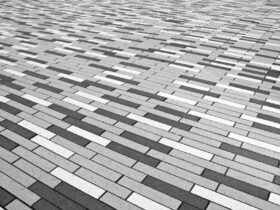To identify slate, look for fine grains and a foliated appearance. Slate is a low-grade metamorphic rock that forms from shale or mudstone.
It is hard, brittle, and comes in varying colors such as black, blue, green, red, brown, and buff. Unlike shale, slate does not absorb water. In the past, slate was used for roofing and even as chalkboards. We’ll explore various methods of identifying slate, including its distinguishing characteristics, texture, and uses.
By the end of this article, you’ll have a clear understanding of how to identify slate and differentiate it from other rocks.
Identifying Slate
Slate is a type of low-grade metamorphic rock that is formed from shale or mudstone. The rock is identifiable by its finely grained texture and foliated appearance. To tell slate from shale, one can look for flat sheet layers, test for hardness, and examine the distinct layers visible in slate.
Slate is a low-grade metamorphic rock that usually forms from shale or mudstone. It is widely used in flooring, roofing, and decorative purposes. Identifying slate correctly requires consideration of certain characteristics, including texture, coluor, foliation, hardness, and distinct layers. Here, we will explain how to identify slate by highlighting each one of these features.
Texture And Grain Size
Slate has a fine-grained texture and is usually composed of tiny grains that are not visible to the naked eye. The grains are typically packed together very tightly, giving the rock a smooth and uniform appearance. When you rub your fingers over a slate surface, you should feel a fine, smooth texture.
Colour
Slate occurs in a variety of colours, including shades of blue, black, green, red, brown, and buff. However, it usually has a dark grey to black shade. The colour of the slate may vary depending on the location and conditions in which it was formed.
Foliation
Foliation refers to the division of minerals in a rock into layers or sheets. Slate typically displays a well-developed foliation. You will see thin, parallel lines on the surface of the slate. This feature results from the alignment of the tiny grains present in the rock caused by intense pressure and heat during formation.
Hardness
Slate is relatively hard, but brittle. You may be able to scratch the surface of the slate with a knife or steel nail. However, slate is more difficult to break compared to shale or mudstone, which are its parent rocks.
Distinct Layers
The distinct layers of slate can be seen with the naked eye. These layers formed from the alignment of minerals and other particles in the rock. The layers are usually evenly spaced throughout the slate rock.
Testing Methods
There are different testing methods that can be used to identify slate. One such method is the water absorption test where you can pour some water on the surface of the slate and observe how fast it is absorbed. You can also use a scratch test where you slide a knife or steel nail across the surface of the rock and check if it leaves a mark. Additionally, you can perform a spark test where you rub a metal file across the surface of the slate and observe the type of sparks produced. However, these tests require some technical expertise and should be carried out by a qualified geologist or rock specialist.
In summary, identifying slate requires observing the texture, colour, foliation, hardness, and distinct layers of the rock. These features can help you differentiate slate from other rocks such as shale or mudstone.

Credit: wcrott.com
Slate Vs Shale
Slate is a low-grade metamorphic rock that is formed from mudstone or shale. It has a fine grain and foliated appearance, making it easy to identify. Unlike shale, it is hard and brittle and does not absorb water. To distinguish between slate and shale, look for their distinct characteristics such as flat sheet layers in slate and rough edges in shale.
Introduction:
When it comes to identifying rocks, it’s essential to understand the characteristics that differentiate them from each other. Two rocks that are often confused for one another are slate and shale. Although they may appear similar, they have distinct differences in their composition, texture, and foliation. In this article, we will discuss how to identify slate, with a particular focus on its differences from shale.
Composition:
Slate is a metamorphic rock that forms from the transformation of shale or mudstone under intense heat and pressure. It is made up of fine-grained minerals such as mica and quartz and has a compact, dense structure. In contrast, shale is a sedimentary rock that consists of a mix of minerals, including clay particles, smectite, and quartz.
Texture and Grain Size:
One of the easiest ways to differentiate between shale and slate is through their texture and grain size. Slate is a fine-grained rock that has a smooth texture and a silky feel. The crystals in slate are so small that they cannot be seen with the naked eye, and the rock feels hard and brittle when touched. On the other hand, shale has a grainy texture with a rough, gritty feel due to its larger mineral particles.
Foliation:
Foliation is a layering that occurs in rocks due to metamorphism, and it’s another way to differentiate slate from shale. Slate has a foliated appearance and can be easily split into thin sheets due to the alignment of its minerals. This characteristic makes it ideal for roofing materials, flooring, and outdoor walkways. In contrast, shale does not have foliation and breaks apart into irregular pieces.
Conclusion:
In conclusion, identifying slate is essential when it comes to construction and decoration. Knowing its differences from shale can help prevent costly mistakes and ensure that the right material is used for the specific application. By examining factors such as composition, texture, and foliation, it is possible to differentiate between these two rocks and make informed decisions for any project requiring the use of slate.

Credit: www.amazon.com
Frequently Asked Questions On How To Identify Slate
How Is Slate Identified?
Slate is a low-grade metamorphic rock that forms from shale or mudstone. It is identifiable by its fine grains and foliated appearance. The foliation of slate is clear, and it is hard and brittle. Its color varies from black, shades of blue, green, red, brown to buff.
Its distinct layers are visible, and it is widely used in floorings, roofing materials and chalkboards.
How Can You Tell Slate From Shale?
Slate is a metamorphic rock and shale is a sedimentary rock. To differentiate slate from shale, check for fine grains and foliated appearance, along with a hard and brittle texture. Slate doesn’t absorb water and has a flat sheet-like layer visible on its surface.
In contrast, shale has rough edges and is composed of fine-grained sediments.
What Helps You Recognize Slate?
To recognize slate, look for its fine grains and foliated appearance. Slate is a low-grade metamorphic rock that forms from shale or mudstone. It is hard, brittle, and available in variable colors such as black, shades of blue, green, red, brown, and buff.
One way to identify slate is by checking for flat sheet layers.
What Are 3 Characteristics Of Slate Rock?
Slate rock has a foliated appearance, fine-grained texture, and is hard and brittle.
What Is Slate And How Is It Formed?
Slate is a low-grade metamorphic rock that forms from shale or mudstone. It is identifiable by its fine grains and foliated appearance.
Conclusion
Identifying slate requires knowledge of its unique characteristics, including its foliated appearance, fine grains, and hard, brittle texture. While shale may be mistaken for slate, using techniques like XRD identification or striking the rock with a hammer can help differentiate the two.
With the right tools and knowledge, anyone can become an expert in identifying slate and other natural stones like a pro.







Leave a Reply